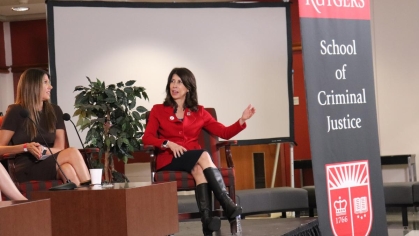Crime Prevention by the Numbers
Rutgers University-Newark researchers will use sophisticated data to reveal crime trends that police can’t see
What is it about certain places that makes them crime hotspots? We know, for instance, that we should avoid dark alleys. But the reasons why some locations—say, a corner store—tend to attract crime more than others may not be obvious even to police.
A research team based at Rutgers University-Newark (RU-N) is doing some sophisticated number crunching to reveal local characteristics that seem to make criminals feel lucky.
“There are places that attract certain types of offending behavior, and that’s what we’re trying to identify,” says Joel Caplan, an associate professor at Rutgers School of Criminal Justice and deputy director of the Rutgers Center on Public Security. “We include data such as bars, schools, grocery stores, subway entrances, laundromats, and car washes – basically features of the built environment.” By correlating patterns of existing crime with ways that these manmade structures are distributed in a community, Caplan – who is leading the research – says his team can give law enforcement and local businesses new insights into making neighborhoods safer.
Caplan and his School of Criminal Justice colleague Leslie Kennedy released version one of their idea, which they call Risk Terrain Modeling, in 2009. Since then, they have achieved several local successes.
One was in Glendale, Arizona, where they found that places within one block of convenience stores were more than 2.5 times as likely to be robbery locations as elsewhere in the city. When police then told them that most crimes in those places were cellphone thefts, Caplan’s data about the presence of the stores spurred a valuable insight that police commanders had never considered.
“They realized that in almost all convenience stores they have these kiosks that allow people to recycle used tablet devices and cellphones,” Caplan explains. “They spit out cash and give you money for used devices.” So, if a robber could steal a device and then redeem it for cash anonymously before the crime was even reported, it was easy money – and the physical evidence of the robbery was already out of the thief’s hands. Kiosks tend to be tucked away in the backs of stores, and Caplan says one risk reduction strategy involved asking store managers to move them near windows where they could be readily observed. Locations in Glendale where police intervened based on Caplan’s data saw crime fall more than 40%.
Now Caplan plans to take the concept even farther by going more deeply into factors that shape human behavior. For that he has enlisted Simon Garnier, an assistant professor in the Federated Department of Biological Sciences that serves both RU-N and the New Jersey Institute of Technology. RU-N has funded this expansion of the research, providing $75,000 to Caplan’s team through one of six Initiative for Multidisciplinary Research Team (IMRT) awards it granted to members of its faculty in 2015.
Garnier’s specialty is “swarm intelligence,” an aid in understanding how large groups of animals or humans – or even robots – perform actions based on cues they take from each other. As Garnier describes it, many swarms are groups of people in the same place at the same time, like a crowd at a ball game where people’s actions feed directly off each other. But a swarm can also be a series of individuals visiting a location over time, each making decisions based on physical cues left behind by those who have been there already.
“A good example is the snow,” Garnier explains. “If someone started walking through a park and it leaves traces in the snow, you’re more likely to follow in the path of this person.” Now, Garnier says, translate that image to crime. “If someone breaks into a house in a neighborhood, it tells others that the neighborhood is weak,” he explains. “I look at information about crime that lingers. If it’s left in the environment, it will motivate the next person to do the same.”
Caplan now wants to take that insight, developed in Garnier’s Swarm Lab at NJIT, unite it with his own work on crime-prone locations, and run with it. “Over time, people choose certain places over and over again,” says Caplan. “What is happening when criminals operating independently seem to target the same places? These places continue to attract offending behavior, and that’s how swarm theory makes sense.” This concept, he says, may have special value in finding ways to keep crime from taking root in traditionally safer locations.
Caplan says there may even be commercial potential in the work the team will do. Police departments have already funded some of his earlier work and used the knowledge gained to improve their crime fighting techniques – for instance deploying police patrols strategically throughout cities in just the right places. “They were no longer playing whack-a-mole with crime,” he says. Caplan hopes the more refined models he now plans to produce will create additional value for law enforcement and future researchers alike.
Photo of Joel Caplan (left) and Leslie Kennedy by Nora Luongo
